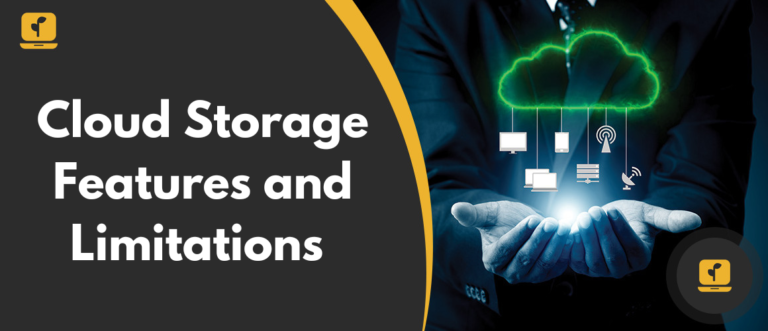Key Takeaways:
- Cloud storage is a popular option for data storage and backup for individuals and businesses alike.
- Cloud storage allows for easy access to data from anywhere with an internet connection.
- Security and privacy concerns should be carefully considered when selecting a cloud storage provider.
- Comparison of pricing, features, and limitations should be performed before selecting a cloud storage provider.
- Utilizing cloud storage can save time, money, and provide peace of mind for data storage and backup.
Table of Contents
I. Introduction
As technology continues to advance, more and more individuals and businesses are utilizing cloud storage as a convenient and secure option for storing and backing up their data. This guide will provide an introduction to cloud storage, including how it works, its benefits, types of cloud storage, how to choose a provider, security and privacy concerns, pricing, and how to use cloud storage.
II. What is Cloud Storage?
Cloud storage refers to a service where data is stored and maintained remotely on servers that can be accessed via the internet. Unlike traditional storage methods, which require physical hardware, cloud storage allows for data to be stored and accessed from anywhere with an internet connection.
III. How Does Cloud Storage Work?

Cloud storage works by using a network of servers to store and manage data. When a user uploads data to a cloud storage provider, the data is split into smaller pieces and distributed across multiple servers for redundancy and security. When the user needs to access the data, the data is retrieved from the servers and reassembled for the user to view or edit.
IV. Benefits of Cloud Storage
Cloud storage offers a number of benefits over traditional storage methods, including:
- Easy access from anywhere with an internet connection
- Automatic backup and synchronization of data
- Scalability, allowing for storage capacity to be easily increased or decreased
- Cost-effectiveness, as there is no need to purchase and maintain physical hardware
- Improved collaboration and sharing capabilities
- Redundancy and data protection through distributed storage
V. Types of Cloud Storage
There are three main types of cloud storage:
- Public cloud storage: offered by third-party providers and accessible to anyone with an internet connection.
- Private cloud storage: dedicated to a single user or organization and often managed on-premises or through a cloud provider.
- Hybrid cloud storage: a combination of public and private cloud storage, allowing for greater flexibility and customization.
VI. Choosing a Cloud Storage Provider
When selecting a cloud storage provider, it is important to consider a number of factors, including:
- Security and privacy measures
- Pricing and storage limits
- Features and capabilities, such as backup and sync options, collaboration tools, and integrations
- Reputation and customer support
VII. Security and Privacy Concerns

While cloud storage offers many benefits, it is important to carefully consider security and privacy concerns when selecting a provider. Factors to consider include data encryption, access controls, compliance with data protection regulations, and vendor lock-in.
VIII. Cloud Storage Pricing
Cloud storage providers typically offer a range of pricing plans, with costs based on the amount of storage needed, number of users, and features offered. It is important to carefully compare pricing and features before selecting a provider.
IX. Cloud Storage Features and Limitations

Different cloud storage providers offer varying features and limitations, such as file size limits, versioning, and collaboration tools. It is important to carefully review these features and limitations to ensure that they meet your needs.
X. How to Use Cloud Storage
Using cloud storage is a simple and convenient way to store and access your data from anywhere with an internet connection. If you’re new to cloud storage, here are some steps to get started:
- Choose a cloud storage provider: Research and compare different cloud storage providers to find one that fits your needs and budget. Some popular options include Google Drive, Dropbox, and Microsoft OneDrive.
- Sign up for an account: Once you’ve selected a provider, sign up for an account by providing your email address and creating a password.
- Install the desktop or mobile app: Many cloud storage providers offer desktop and mobile apps that make it easy to upload and access your files. Download and install the app on your devices.
- Upload your files: To upload your files to the cloud, simply drag and drop them into the app or select the files you want to upload and click “upload”. You can also create folders to organize your files.
- Access your files: Once your files are uploaded to the cloud, you can access them from any device with the app installed and an internet connection. Simply log in to your account and select the file or folder you want to access.
- Share files with others: Cloud storage also allows you to easily share files with others. Simply select the file or folder you want to share and click “share”. You can then enter the email address of the person you want to share the file with and choose the level of access you want to grant them.
- Backup your data: Cloud storage can also be used as a backup solution for your important data. Set up automatic backups of your files to ensure that you always have a copy in case of a device failure or other issue.
By following these steps, you can quickly and easily start using cloud storage to store, access, and share your files.
XI. Conclusion
Cloud storage is a convenient and secure option for data storage and backup, offering easy access from anywhere with an internet connection, automatic backup and synchronization, and scalability. When selecting a cloud storage provider, it is important to carefully consider factors such as security and privacy, pricing and storage limits, features and limitations, and reputation and customer support. By utilizing cloud storage, individuals and businesses can save time, money, and ensure that their data is protected and accessible at all times.








